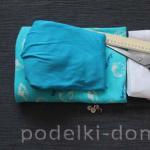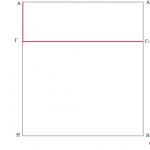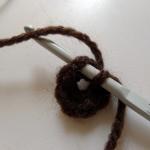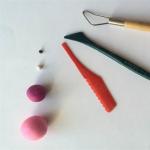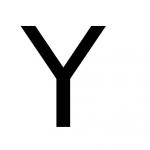Electronic pattern for women's winter overalls. Winter overalls for boys with zipper and warm fleece
Hello, Zimushka-winter!
For children, the new arrival of winter means new fun, new experiences! The quality of these childhood experiences is directly proportional to parental responsibility. In order for a child to have a successful walk, first of all, he needs appropriate clothing. The most suitable option for winter snowball fights, sledding or skiing is, of course, overalls.
Overalls will reliably protect the child from the winter cold, provide comfort and freedom of movement.
We offer you pattern, according to which you can sew a jumpsuit like for girl, so and for boy.
Ready-made pattern for children's winter overalls
Height 110cm
Bust circumference 56cm.
Children's winter overalls with insulation, straight silhouette, optimally voluminous, zipper in the middle of the front, stand collar. The sleeves and legs at the bottom are gathered with elastic or cuffs. The belt is worn over the overalls with a latch buckle. There is an elastic band inside the waistband. The overalls can be complemented with a hood. Hood pattern for this size is available in . The hood can be made detachable or sewn into the neckline.
Preparing the pattern for work is extremely simple.
Click on the diagram located at the end of the article and baby overalls pattern opens in a new window.
Print out the pattern sheets, cut and connect them according to the diagram.
Be sure to check the scale for consistency. On a printed sheet with a 10x10 cm square depicted, sides of 10 cm should correspond to exactly 10 centimeters.
This pattern can serve as finished pattern, and can be used as modeling basis. You can apply additional relief lines, add yokes, pockets, knee pads, etc.
The figure conventionally shows finishing trims on the sleeves and on the legs. You will also determine the location of these trims yourself, at your own discretion. You can refuse them and decorate the jumpsuit in any other way, for example, embroidery or appliqué.
You determine the emphasis of the product yourself. This can be a combination of contrasting fabrics, piping, trim, decorative stitches, various accessories, etc.
Stand collar can be made in different variations: fur, fleece, knitwear, etc.
In addition to the main details, you need to cut a belt, the length and width of which you can calculate yourself, depending on the type of buckle, the width of the elastic and its elasticity.
Before you start cutting, as always, you need check the pattern. Take the time to take a centimeter and compare the measurements you took with the dimensions of the drawing.
The pattern is given no seam allowances.
The lining and insulation are cut according to the main patterns.
In the following articles we will continue the topic of winter clothing for our little clients.
If you have any difficulties with printing patterns, write to us and we will post a master class with the details of this process.
I will sew online, that is, together with everyone, taking my time, gradually laying out the sewing process, and answering questions along the way. I will post each stage in a new post, leaving links to previous and subsequent stages. Girls, you can do the same on your blog (magazine, topic, or just in my comments), post your steps with explanations or questions, clarifications, etc.
I warn you that there will be a lot of writings and photos. That’s why, most likely, I leaned towards step-by-step sewing rather than immediately ready-made volumetric MK. I don’t promise to photograph everything beautifully and colorfully, but I’ll try to make it clear and not completely dirty and blurry)))))
In general, I will sew a jumpsuit in the image and likeness of this one for my Ksyusha. I’m not sure about the fur yet, but if there are a lot of people who want to attach the fur, I’ll show you.
There are few details in it. Quite a simple model. There will be no inserts or decor. All from the same printed fabric. I have this jacket fabric with a membrane coating with the image of rainbow zyobers))))
The lining will be fleece and omnikhite. You can take a regular lining, or you can make one lining for the entire height. But full-length fleece will not be very comfortable, I think. That's why I only put it on the front and back up to the butt. Below will be the Slidsky Omnihit, and it will also be in the sleeves. There will be fleece on the collar and hood. I took the TricotBrush, which I had previously put in my other overalls, but it’s out of stock, unfortunately.
And so, my list of necessary materials for insulated overalls size 98-104.
Raincoat - 1.5m
fleece - 0.5m
omnihit (lining) - approximately 1m
insulation (I have Alpolux 200 for winter) - approximately 1m
zippers:
- main - 1 PC
- on the pockets - 2 pcs
- on the fastened hood - 1 PC
wide elastic band 3cm for cuffs - 80cm is enough
decorative elastic band for straps - approximately 1m
hat elastic for tightening - approximately 1m
Velcro
threads
fasteners for drawstring - I have found two things that match the color so far, maybe I’ll take others and make a drawstring on the hood, I don’t know yet...
In my photo I also have an additional gray raincoat fabric for the pocket and frames. Perhaps it won’t be needed, it’s just that the pattern of my main fabric is directed, you can’t turn it anyhow, in case it’s not enough, so I played it safe. But it should be enough for the main details.
I take the pattern from Ottobre magazine 2014-4, model 14. For my daughter’s height of 94 cm, I take the size of this pattern 104. As the practice of sewing this pattern has shown, for winter insulation it is good to take a size one larger than the child’s own. That is, Ksyusha’s native size is 98, one more - 104. This is quite enough, the pattern is good, in my opinion, the width is sufficient.
The changes I make to it are very minor: for reserve for growth, and in general for some convenience I increase the length of the legs and sleeves by 4cm! The larger the size, the greater the magnification. Well, you also need to look at what is planned for the legs and sleeves. I have cuffs, my formula is +4cm. The growth margin turns out to be exactly 10 centimeters. That is, a child with a height of 92 to 102 cm can fit well in this size.
I make the collar 1.5 cm higher. I measured this clearly today. Before that I somehow added it by eye))
Well I'm converting the hood into a two-seam one. This is my personal preference. Not necessary.
I don’t touch the armhole, sleeves or neckline. But perhaps someone will need to lower the armhole a little and widen the sleeve. Girls, look at your children. These narrow sleeves suit me quite well. And, unfortunately, I can’t tell you how to change the armhole...
Today you will find out how to sew a onesie for a newborn with your own hands. Sewing master class by Nadya Britvina.
A light knitted jumpsuit is simply a necessary thing for a baby; in cold weather it can be used as an underwear under warm clothes, and on warm days - as an independent item. The fabric for sewing overalls should be stretchable and soft, I used knitted terry.
Necessary materials:
- main fabric 50 cm,
- fabric for finishing (highly stretchable knitwear or ribana is used) - 10 cm with a width of at least 150 cm,
- pattern,
- tailor's scissors,
- sewing threads,
- interlining,
- ruler,
- tailor's chalk (a dry piece of soap will also do),
- overlock,
- metal buttons and a press for installing them (buttons can be replaced with buttons).

So, let’s sew a jumpsuit with our own hands. Sewing progress:
1. Print out the pattern. These dimensions are given for a child up to 56 cm in height; if desired, the pattern can be easily increased by adding a few cm along the shoulder, step and bottom sections.

2. Using chalk, transfer the pattern to the fabric, folded with the right side inward, the lobe is located along the details of the overalls. The material must first be washed, dried and ironed. We place the back part with the fold facing the fold of the fabric. We cut out parts of the product, adding allowances of 7-8 mm on all sides. We get one piece of a one-piece back, two shelves, two sleeves.

3. Cuffs for the bottom of the sleeves and trouser legs (4 strips 8 cm wide, 17 cm long), a collar (a strip for processing the neck on the pattern) and two straps for fastening 31 cm long, 5 cm wide are cut out of the ribana. It is advisable to choose a finishing fabric that matches the color of the main material well.

4. In order for the fastener strips to keep their shape well, they must be glued with non-woven material (special reinforcing material, glued to the wrong side with the adhesive side down using an iron).

5. We bend the strips glued with non-woven material lengthwise and iron them.

6. Sew the strips to the central sections of the shelves at a distance of 0.7 cm.

7. We sew the stitching sections from the side of the slats.

8. On the front side of the shelves, we sew off the allowance for sewing the strips with a stitch to the width of the foot.

9. Place the strip one on top of the other and fasten it with machine stitching at the bottom.

10. Fold the shelf with the back right side inward, grind and overcast the shoulder sections.

11. We baste and stitch in the sleeves, sewing the stitching seam from the side of the shelf. It turns out to be such a vest.

12. Sew the sleeve seams and side seams with a single stitch. This method of joining sleeves is much simpler than sewing finished sleeves into armholes. We sew down the step cuts. If you can’t sew smoothly right away, then first baste everything by hand. We sew all the cuts from the side of the shelves.

13. Fold the cuffs right side inward and grind the cross sections.

14. Turn the cuff onto the face, put the sleeve/trouser leg into the cuff, align the transverse seams, align the cuts and stitch at a distance of 0.7-0.8 cm. When sewing the cuff, slightly stretch it.

15. Sew the seams on the cuff side.

16. Fold the collar (neck strip) lengthwise with the right side facing out, stitch it to the neck, evenly distributing the fit, overcast the collar stitching seam. At the ends, we secure the overlay stitch with knots or manually.

17. On the front side, we sew a finishing stitch along the neckline at a distance of the width of the foot.

18. All that remains is to install the buttons using a press, or simply sew buttons on one bar and sew loops on the other

and iron the product along all seams.
The onesie is ready, the baby will feel good and comfortable in it.”


As you can see, sewing overalls for a baby with your own hands is quite possible for a mother or grandmother who knows how to sew.
Another option for a creative gift for a newborn is personalized bodysuits:


More interesting:
See also:
Booties for girls in the form of sandals (crocheted)
Elena Khorolskaya again pleases us with a new master class on how to knit booties-sandals for a red girl...
We sew a skirt for a girl
It's no secret that the site is not only an excellent trading platform where you can purchase everything you...
Pink booties (crocheted, with patterns)
Bright booties for newborns are relevant at any time of the year, especially in autumn and winter. Knitted booties...
Knitted jumper for boys (knitted)
A cozy jumper for a 4 year old boy (height 110 – 116 cm) was knitted by Svetlana Elina. To knit this...
Summer suit for girls "Wave", crocheted
I want my child to wear beautiful, bright and original clothes in the summer. Create beautiful models...
Crochet hat for girls (summer)
Every mother knows that in summer the baby's head must be protected from the sun to prevent...
Greetings to all craftswomen and mothers of babies! I know that among my readers there are young mothers who want their children to be comfortable in the clothes that are chosen for them. I want to offer you overalls pattern for baby. With its help, you can sew such a necessary and practical thing yourself. Your child will feel very comfortable in it.
A similar wardrobe item for children is now very popular and everyone probably has it. But if you wish, you can have as many of them as you want. It is enough to buy a beautiful, bright fleece and sew several overalls for your baby with your own hands and change them at least every day.

The pattern is designed for the following sizes:
Chest circumference – 55-56 cm
Waist circumference – 51-52 cm
Hip circumference – 56-58 cm
Back length – 22-23 cm
Sleeve length – 28-31 cm
Neck circumference – 26-27 cm
Height - 86 - 92 cm
TO WORK ON THE OVERALLS YOU WILL NEED
Fleece 1.15 cm with a width of 150 cm
Elastic band (elastic band) 1.10 cm wide 1 cm
Nonwoven
The pattern is given without seam allowances. They will need to be made when cutting: along the cuts - 1.5 cm, along the bottoms - 2.5 cm.
1 – front half (2 parts)
2 – back (2 parts)
3 – sleeve (2 parts)
4 – hood (2 parts)
5 – middle part of the hood (1 part with a fold)

On pattern number 1, there is a 5 cm wide placket along the middle of the front. This is a selvedge. It needs to be re-shot as a separate additional detail.
To finish the edge of the placket and hood, you will need bias binding 1.5 cm wide (full width 3 cm). You will find information on how to make it yourself. On the layout plan, the shaded areas must be covered with non-woven material.
The picture shows the most appropriate arrangement of parts.

DESCRIPTION OF WORK
1. Sew the back seam
2. Sew the sleeves to the back and front halves of the overalls along the raglan line
3. Sew darts on the hood
4. Sew the middle part of the hood to the side parts
5. Sew the hem along the edge of the front, having previously glued it with non-woven fabric.
6. Sew the hood into the neck of the overalls
7. Apply bias tape to the front and hood sections
8. Add buttons
9. Sew side and crotch seams on the overalls
10. Fold the hem on the sleeves and legs
11. Insert elastic bands
That's all! The baby's overalls are ready! As always, we got it done quickly enough. In such an outfit any child will feel comfortable and warm.
If you wish, you can dream up and come up with a model that will combine different fabrics, different colors and textures. For example, the front and back are made of multi-colored fur, and the sleeves are made of plain fleece or thick knitwear. Come up with your own original combinations.
I hope you liked this proposal. Check out the section. There you will find many more interesting and useful things for you and your family members.
Sew with pleasure and to the delight of your loved ones!
Leave your comments and ask questions if you have any.
Find out even more interesting things:

Fluffy skirt without a pattern
Greetings to all sewing lovers! Today I have prepared a very tempting offer for you. To create the chosen model, you don’t even need to make a paper pattern. Everything is drawn...

Wolka hood pattern
So many good things in the world happen by chance. For those who are not yet familiar with the new trend in the line of hats, this will be pleasant...
Winter is coming - a time for fun winter fun and games in the fresh air. What can cause more emotion in parents than the sight of children squealing joyfully, running races along snow-covered alleys and playing snowballs? However, do not forget that winter is also a cold season, when the likelihood of colds is increased. Therefore, for caring and wise parents, winter is a reason to update and replenish their children's wardrobe, because it often happens that children have already outgrown their winter clothes from last year.
Children's overalls with a hood - we meet winter fully armed
Today we will talk about how to sew a children's jumpsuit with a hood with your own hands. After all, a child who fearlessly faces the winter not in something bought somewhere in a store or at the market, but in something sewn by mother’s hands, providing the maximum level of comfort and warmth, will certainly be a reason for special pride and tenderness for any mother.
Contrary to popular belief, you do not need to be a professional in this field to sew children's clothes yourself. The main thing you will need is a pattern for a children's overalls with a hood, inexpensive materials that are now sold in every fabric store, some cutting and sewing skills and a little free time.
Cutting and preparation of material
As for the material that we will use, its choice depends entirely on your desires and imagination. The main thing when choosing is to take into account that we are sewing for children, so the following requirements for the material are mandatory: it must be practical, strong and, if possible, wrinkle-free, and at the same time it must repel dirt, dust and moisture.
The main fabric should be approximately 60 by 100 centimeters in size; the lining is best made from quilted material of the same size. It is clear that we choose the dimensions of the lining approximately the same. Also, for decoration you may need a little decorative fabric, we believe that there should be no problems at all; various scraps and strips of such fabrics can probably be found in the storage rooms of any housewife. You will also need an elastic band about 30 centimeters long, a cord about 70 centimeters long, a flat zipper about 20 centimeters long and a spool of strong thread.
You can download the finished pattern at the end of the publication. It is best to print it on a printer in a one-to-one size, cut it out, and then draw the fabric using paper templates. When cutting the material, keep in mind that it is necessary to leave allowances of one centimeter.
Let's start sewing
When assembling the overalls, you first need to sew the middle and shoulder seams on the back. After this, the seam allowances must be ironed. Then we sew in the hood along the neck line. Now the sleeves are next - we sew them into the armholes. After this, you need to sew the middle front seam.
Next, we repeat all these operations for the lining - in fact, we assemble another jumpsuit from it. When the lining is ready, we put it inside the overalls, carefully align all the seams, sections of the sleeves and bottom, then attach the lining and measure. At this stage, it will still be possible to change something if it doesn’t turn out quite as it should (afterwards, of course, you can also fix something, but it will take much more time and labor).
Now you need to sew the side seams into the sleeve seams and crotch seams. After this, the allowances in the middle of the front on the front parts of the main and lining fabrics will need to be turned inside out and ironed. At this stage we sew in the zipper, and now we turn in the upper edges of the braid.
As for the neckline, it should be turned on the wrong side, basted and stitched. Now all that remains is to thread the cord into the drawstring and secure the stops at its ends. We thread the elastic through the bottom of the sleeves, tighten them and then sew up the hole.
Now our turn is the hood. On the front and lining fabrics, you need to sew the middle seam, align and process the seam allowances using an iron. After this, attach the front fabric and the lining to each other, stitch the edges, iron the hood, turning it to the right side.
All that remains is to decorate our jumpsuit. An applique made from the decorative fabric that we have prepared is well suited for this. It all depends on your artistic taste and skill, we sew the applique on the front part and our children's overalls are ready. Now little fidgets are not afraid of winter with its cold weather!


